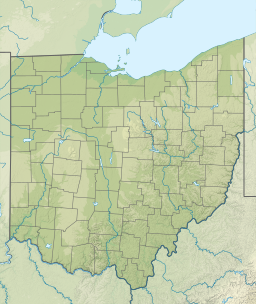| Indian Lake | |
|---|---|
 Bridge at Russells Point, last remaining part of the Sandy Beach Amusement Park | |
| Location | Logan County, Ohio, United States |
| Coordinates | 40°28′03″N 83°52′31″W / 40.46750°N 83.87528°W[1] |
| Lake type | Reservoir |
| Primary inflows | North and south forks of the Upper Great Miami River, Cherokee Mans Run, Blackhawk Creek, Van Horn Creek |
| Primary outflows | Great Miami River |
| Basin countries | United States |
| Surface area | 5,104 acres (2,066 ha) |
| Average depth | 10 feet (3.0 m) |
| Max. depth | 24.8 feet (7.6 m) |
| Surface elevation | 995.8 feet (303.5 m) |
| Settlements | Russells Point, Lakeview |
| References | [1] |
Indian Lake (formerly Lewistown Reservoir) is a reservoir in Logan County, western Ohio, in the United States. It is approximately 20 miles (32 km) southeast of Lima. It is fed by the north and south forks of the Upper Great Miami River, Cherokee Mans Run, Blackhawk Creek, and Van Horn Creek. The outlet of the lake, at the bulkhead or "spillway" (located at what is now State Route 366) built in the 1850s by Irish laborers, is the beginning of the Great Miami River. At 5,104 acres (2,066 ha), Indian Lake is the second largest inland lake in Ohio.
Indian Lake has numerous islands, including the "Indian Isles" chain that arcs through the center of the Lake, expansive wildlife areas accessible by a network of channels, numerous inlets and bays, and approximately 30 miles (48 km) of shoreline. The lake, and adjoining Oldfield Beach (the end point of a several mile, lake-front biking/walking trail), Moundwood and Lakeview Harbor boat ramps, marinas at Moundwood and at Cherokee Campgrounds, and other greenspaces including Pew Island, are managed by the Ohio Department of Natural Resources as part of the Ohio state park system. Popular state walking trails are located, in addition to the one ending at Oldfield Beach, at Pew Island and at the Cherokee Campgrounds.
In its early days extending into the middle of the 20th century, the lake was primarily a destination resort, with many waterfront cottages being lightly built primarily for summer use. Many knew of it as the location of the amusement park with its roller-coaster and other rides and a dancehall, discussed below. While still busiest in the summer, since the late 20th century the lakefront has become developed as an area of second or retirement homes, with many new permanent houses, and remodeling of numerous older cottages.


